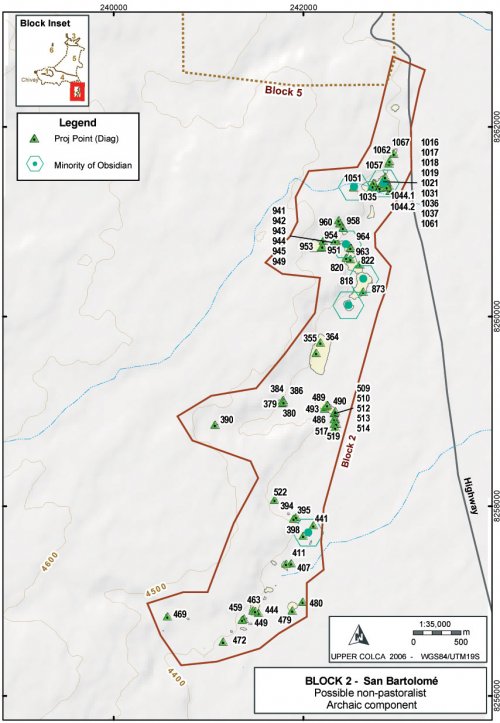Site Type: Sites with majority non-obsidian lithics
A substantial Archaic presence in Block 2 takes the form of diffused, low density scatters with associated diagnostic projectile points along the edge of the pampa and frequently close to water sources. These finds are very difficult to differentiate from the pastoralist site occupation pattern and therefore these features will be described as a group, followed by generalizations about the characteristics of the environmental and cultural features of sites of this type in Block 2.
While the Archaic Foragers use of space largely overlaps with pastoralist occupation areas in Block 2, the use of lithics appears to differentiate the two. As was discussed in Chapter 3 (Section 3.4.4), the use of obsidian for projectile points expands dramatically at the end of the Archaic Foragers period both near the Chivay source and in the consumption zone.

Figure 6-22. Block 2 Archaic Foragers component from lithic evidence.
Method
The criteria used here for sites isolating through the dominance of particular material types are as follows for both lab analysis Lithics_I and Lithics_II. First, the lab results by SiteID (or isolated ArchID), showing count and percent, were shown in a table against material type in Arcmap. This table was joined to the All_ArchID_Centroids point geometry [link to Processing in Ch 5] so that lab results for lithic material types were aggregated by site or isolate. These features were then filtered by constructing a query where the artifact count for a geographical feature had to be greater than 5 so that relative percentages were meaningful. Finally, the index symbolized inFigure 6-22 is the Lithics_I lab results (the most comprehensive table) where Percentage of Non-obsidian lithic artifacts is greater than or equal to 50%.
Results
The use of non-obsidian materials such as chert, chalcedony, and especially fine-grained volcanic materials, dropped precipitously during the Terminal Archaic at sites in Block 2. While all lithic material types persist in use during the pastoral period, the herd management tasks of butchery and shearing appear to have been largely conducted using obsidian. Reviewing the percentages of sites with strong evidence of a pastoralist occupation (only Series 5 projectile points, a corral, water, and grazing opportunies) these sites commonly have between 20% - 40% non-obsidian flaked stone. Thus, the distinction between pastoralist and forager components based on material type is not firm, but the distributional pattern is reinforced by non-series 5 projectile point distributions, and this evidence is shown together in Figure 6-22.
Six sites have been identified with a relatively robust Archaic Foragers component in Block 2 and the environmental characteristics of these six sites will be compared with all locational characteristics of B2 sites in order to look for patterning among the environmental criteria of Archaic Foragers sites. These six sites include the following A03- 396, 884, 894, 900, 1014, 1049 and while diagnostics from the Archaic Foragers period were widely encountered throughout the region, these sites are selected as representantive for the larger Archaic Foragers time period and life way based on inference. Clearly the boundaries of the "site" are probably not coterminous with the Archaic Foragers component of these sites, nevertheless these measures serve as a general indicator of changes in the environment context of settlement through time.
|
Selectedm |
Selecteds |
All B2 Sitesm |
All B2 Sitess |
All B2 Sitesm - Selectm |
|
|
Altitude (masl) |
4382.6 |
12.69 |
4393.2 |
25.7 |
-10.6 |
|
Slope (degrees) |
7.86 |
8 |
8.33 |
6.34 |
-0.47 |
|
Aspect (degrees) |
146.5 |
96.4 |
138.4 |
58.23 |
8.1 |
|
Visibility/Exposure |
33.6 |
13.1 |
40.1 |
25.53 |
-6.5 |
|
Dist. to Bofedal (m) |
497.3 |
212.2 |
307.5 |
261.5 |
189.8 |
Table 6-33.Environmental characteristics of selected Archaic Foragers sites in Block 2.
The high standard deviation values in the Table 6-33 "Selected sites" underscores the variability and inconsistency in these estimates. This comparison shows that the Archaic Foragers sites tend to be more sheltered/lower visibility than the pastoralist sites. As was previously noted, the Archaic Foragers sites are often adjacent to overlooks but the sites often do not occupy the high exposure area specifically. Archaic Foragers sites are considerably further than average from bofedales. This strong tendency in the data is probably accentuated by the intensification and maintenance of pastoral resources that has occurred in recent years. That is to say, as pastoralism is today the principal economy activity in the area, bofedales and attendant pastoral facilities have been well-maintained in the recent past, which is the criteria from which bofedales were selected from the ASTER satellite imagery for this measure. A further issue with respect to distance to water is the fact that many of the potential forager sites are adjacent to small streams that were probably seasonal and appear as dry in the modern dry-season ASTER imagery.